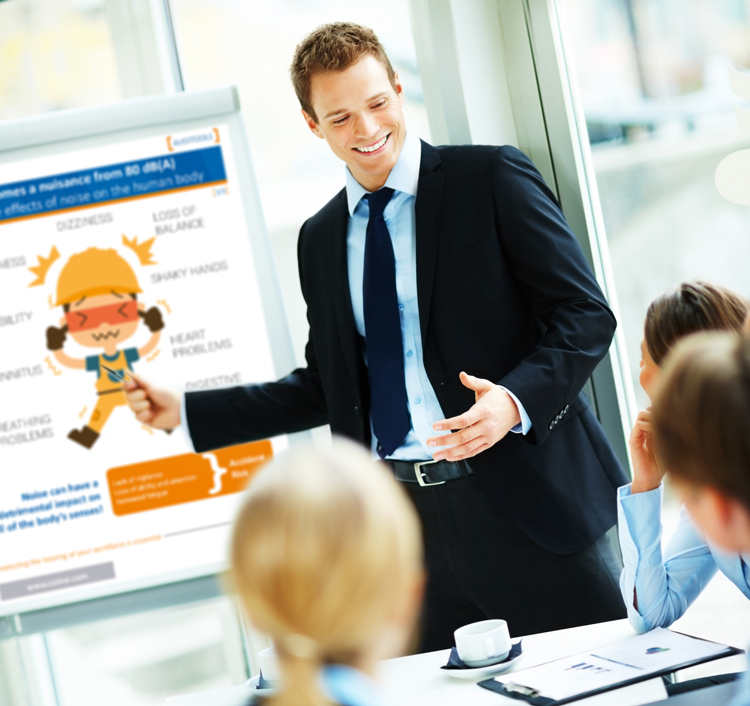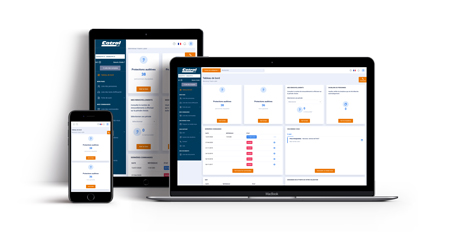Employers are required to train employees exposed to noise levels above 80 dB(A). This obligation is intended to develop new behaviour with respect to noise risk.
Beyond the legal aspect of training and information, an American study has shown that employees trained in noise risk better protect themselves. When they understand the risks, they adopt good safety practices, such as wearing their hearing protection at all times when they are exposed to noise.
How can you effectively get your message across and permanently change your employees' habits? What steps should you take to ensure the success of your noise risk prevention campaign?

Evaluate the level of knowledge of noise risk
Do you want to set up a prevention campaign but don't know how to do it? First of all, it is recommended that you prepare a three-step assessment.
Step #1: Test your employees' knowledge
Do your employees know the impact of hearing loss? At what thresholds does noise become a danger? What are the visible (hearing difficulties, tinnitus, etc.) and invisible (fatigue, stress, difficulty concentrating, etc.) impacts on their professional and private lives?
The aim here is to assess the situation before you take any action. Feel free to regularly test your employees' knowledge during your prevention campaign to measure its effectiveness.
Step #2: Assess the noise risk
What are the situations in which noise is a danger in your company? What means of prevention have you already put in place? Let's take a few examples.
Mr Smith works at a metal stamping company. He wears his earplugs all the time at the press but does not have them in his ears when he walks through the workshop to his workstation. In doing so, he puts his hearing at risk by exposing it to the noise of the workshop and machines.
Ms Mc Hugh needs to communicate regularly with her colleagues in the same workshop. To do so, she used to lift one side of her helmet. This situation is also dangerous because hearing protection that is not worn for two minutes in an eight-hour day loses 25% of its effectiveness.
These examples from daily life must be evaluated so that they do not recur. Feel free to record these dangerous situations in a risk sheet.
Step #3: Analyse the data and establish an action plan
What lessons can you learn from the knowledge of your employees and the risk situations at your company? Do you identify priority actions to be taken?
Thanks to the analysis of the knowledge questionnaires and the risk assessment, you get a more complete overview of the situation and a better view of the areas for improvement to raise awareness of noise risk at your company.
Raise awareness collectively
Collective awareness is an essential step in your prevention campaign. Unite your employees around a common objective. Motivate them regularly! They will be involved and empowered in a sustainable way. This awareness is achieved through displays and prevention workshops.
Set up prevention workshops
Put noise awareness at the heart of the discussion. You can do this yourself or use an external consultant. Try not to exceed 20 people so that your employees can actively participate.
For example, you can plan 15 minutes for safety. This moment of exchange allows you to disseminate information about workplace safety and to engage in dialogue with your employees on different topics. For it to be effective, it must be properly prepared in advance.
Use posters

One of the most effective channels is visual support through awareness posters. Some tips to make your display campaigns a success.
Communicate clear messages
There is no shortage of topics to discuss to raise awareness among your employees. For example:
- The importance of wearing hearing protection 100% of the time when exposed to noise
- The functioning of the ear
- The effects of noise on hearing
To make it easier for your employees to identify with noise issues, use concrete examples related to your company's activity.
Focus on the attractiveness of visuals
The way you present your materials is as important as the topics themselves. Make sure your posters are visible from a distance and attract the attention of your employees. Use large font sizes and feel free to use pictures.
Place displays at multiple locations
Your campaign aims to increase noise awareness, so your posters must be displayed in strategic places that your employees often visit, such as at the entrance to workshops, in changing rooms and in break rooms. To reiterate the messages, consider switching your posters regularly to keep your employees focused on noise risk.
Raise awareness individually
Individual awareness complements the actions carried out collectively in your company. Thanks to this, your employees feel valued and respected.
Involve human resources
Formalise the discussion and put prevention at the heart of your company's strategy by involving human resources. For example, include your messages on pay slips to individualise your campaign.
Schedule information appointments
Use meetings with occupational medicine to underscore the topic of hearing health and the actions to be taken to protect yourself individually.
Complement the group training sessions with individualised content
Prepare materials that your employees can keep after your group workshops to complement and individualise your actions. These media (comic strips, postcards, etc.) improve risk awareness for your employees and develop responsible behaviour.
Train your employees
To ensure that your prevention campaigns are relevant, train your employees by addressing the essential topics of noise management in the workplace:
Noise is a source of risk
Hearing is in danger when the noise level exceeds 80 dB(A) over an eight-hour work day, not to mention the indirect effects on the body (fatigue, nervousness, etc.). All your employees must be aware of this fact to maintain their health.
Wearing hearing protection 100% of the time when exposed to noise
Hearing protection that is not worn for two hours during an eight-hour day loses 75% of its effectiveness. Encouraging employees to protect themselves throughout the duration of their exposure is a guarantee of effectiveness.
Insert the hearing protector in the ear properly for optimal protection
If a hearing protector of any kind is not comfortable for the user, it will not be worn. Be sure to cover this topic to increase the adoption of your solution by your employees and prevent the risk of sound leakage.
Remember that these topics must be repeated regularly to keep your employees involved.
Plan your actions over time
To get organised, you can plan a three-month prevention campaign.

All these actions will allow you to achieve your goal of "No work-related deafness" in your company.
https://www.youtube.com/watch?v=0QBi0l9aAiY
